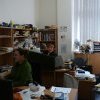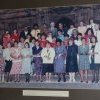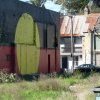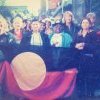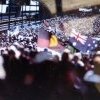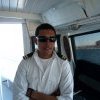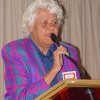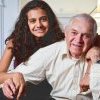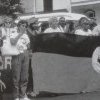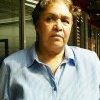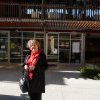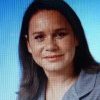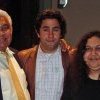2000s
2000
The Yiribana Gallery at the Art Gallery of NSW with curator Hettie Perkins is established as one of the world’s largest spaces dedicated to the permanent display of Aboriginal and Torres Strait Islander art. The Gallery’s collection of Indigenous Australian art is also one of the broadest in the country. Almost one-third of the works acquired for the collection since 1992 have been through the generosity of Mollie Gowing. Recent ACB-funded acquisitions include paintings by Fred Ward Tjungurrayi and Mabel Juli and a video work by Michael Riley and Destiny Deacon.
The Koori Centre, University of Sydney offers a block mode course for regional NSW Indigenous students. The Diploma in Education (Aboriginal) is a 2 year course which offers students education skills training. The Diploma in Education articulates directly into the Bachelor of Education (Secondary: Aboriginal Studies).
The Tribal Warrior Association is formed to train Aboriginal people in Master class in Commercial Maritime Certificate and Marine engineering and Radar Certificate. The Tribal Warrior uses a Gaff rigged ketch Deerrubun to train on. They run harbour cruises and culture tours around Sydney Harbour. (V46, ‘Tribal Warrior Harbour Cruises’)
'Wuganmagulya’ (Farm Cove), an artwork created by Brenda Croft, is opened by the Lord Mayor Frank Sartor in the Royal Botanic Gardens, Sydney. Croft speaks at the opening ceremony, ‘I did this work for the people of this place, Warrang/Werang, which has become known as Sydney. For the people of this place. You cannot live here respectfully if you do not acknowledge who inhabited the space before you. You also have to think about those who will come after you, and realise the impact of your actions on them.’ (Heiss, 28-31)
Anthony Mundine is named the Aboriginal and Torres Strait Islander Person of the Year, after converting to Islam in 1999. Until becoming a professional boxer he plays football for St George-Illawarra Dragons. Among his accomplishments are professional super-middleweight class boxer, 2001-; world title holder, 2003. http://www.answers.com/topic/anthony-mundine#ixzz1RHa8qYy0
Ten people including Isabel Coe use rowing boats to storm the fences of Cockatoo Island. Coe states, ‘Claiming Cockatoo Island for Aboriginal people', they then set up an Aboriginal Tent Embassy. On the island's highest point, the activists light a flame to begin the healing of the island and to assert title to the island for "ceremony, healing and to set in place the treaty process’.
The Aboriginal Education and Training Unit of TAFE NSW and OTEN provides educational, cultural advice and support to Aboriginal and Torres Strait Islander people. Both face to face and distance education is provided. Certificate Courses such as Education Support, Aboriginal Culture, Aboriginal Issues and Vocational and Study Pathways are offered.
At Macquarie University, Warawara - Department of Indigenous Studies is an Academic Department located within the Faculty of Arts. Apart from teaching Indigenous studies across the university, Warawara facilitates an alternative entry program aimed at providing access for Indigenous people to undergraduate courses across the University. The research specialties include Indigenous education and health, Indigenous methodologies, rock art archaeology and Aboriginal Astronomy. Warawara also offers two residential or "Block attendance" courses. One of these is the Bachelor in Community Management while the other is the Bachelor of Teaching (Early Childhood). In addition to facilitating educational opportunities for Indigenous people, Warawara also offers student support to Indigenous students enrolled across the University.
2000 - 2010
2001
The Koori vessel Tribal Warrior sets out to circumnavigate Australia in a timber hulled pearling lugger more than 100 years old. She carries a crew of seven Aboriginal/Koori men. The voyage lasts 648 days. They visit 120 Aboriginal communities, over 26,000 kilometres. This is the first circumnavigation of Australia in a sea going vessel crewed only by Indigenous Australians (V46 ‘Tribal Warrior Harbour Cruises’)
'The Block', Community Social Plan wins both national and international awards. A historian of the new plan for the Block writes, ‘It includes renovation of all the houses, demolition of back fences to establish a large communal area, the establishment of a health clinic to care for alcoholics and the sick, houses for married couples and families, and other groups of single people, a pre-school to be run by Aboriginal mothers, training workshops for young people, and a cultural centre to encourage Aboriginal languages and dancing. This master plan is claimed to be the first for an Aboriginal community’. (Pitts p. 3/9, 4/22)
Uncle Chicka Madden retires from the railways, owns his own house and car, is on the Board of the Aboriginal Medical Service, Treasurer of the Metropolitan Land Council for several years, is a life member of the Redfern All Blacks Rugby League Club, is, and attends Eora College with Uncle Cec Bowden. (V 48, Now I think they’re proud of being Aboriginal’)
2002
Jonathon Jones writes, ‘To overcome this issue of appropriation of ‘traditional’ Aboriginal art and the general lack of understanding of contemporary urban Aboriginal culture, we need to expand the narrow stereotyped notion of Aboriginality that mainstream society has created. The education of the community is the foundation of change. To achieve this major re-education of the mainstream community it needs to be facilitated through educational institutions and the major art and cultural institutions. Creating an environment where the mainstream community realises, accepts and respects the reality of urban Aboriginal culture, and in turn Aborigines, so we can feel comfortable with who we are.’ (Heiss, p. 59)
The poet Kerry Reed-Gilbert writes, (Heiss p. 55)
Sydney, what can I say I wanted a new life And came here to stay. Sydney, you’re a terrifying city especially for a blackgin especially for a Black chick from a little bush town. Your lights are so pretty Your building so big The crowds are so thick I just get lost in. Don’t know where to walk Or which turn to take.
2002 - 2005
2003
2004
A Community Justice Group is set up in Redfern to provide direct ways for Aboriginal people to become involved in solving their own justice problems. The group works to enable Aboriginal people to be involved in the Justice system so that it works for them and their community both as victims and offenders.
2005
The Aboriginal and Torres Strait Islander Board of the Australia Council (for the Arts) makes important changes to the Indigenous arts landscape by supporting artists and protecting their artistic works. These changes evolve from recommendations of the Creating Pathways conference for dance (2005), the Senate Inquiry into Indigenous visual arts (2006), Making Solid Ground: Indigenous infrastructure and key organisations review (2008), the development of the Indigenous Australian Commercial Code of Conduct for the visual arts (2009), Song Cycles: An audit of support infrastructure for Indigenous music in Australia (2010), Indigenous Cultural Festivals: evaluating impact on community health and well-being (2010) and the National Indigenous Theatre Forum (2010).
A Koori resident of Redfern says ‘I would like to see the community back to the way it was – everybody sort of knew each other’s kids – and they all looked out for each other – and everybody knowing each other that lives there – moving the drugs out. Just be able to give the Aboriginal people, not an advantage, but give them a little something to help them on their way. With housing – hopefully they can get jobs from that … I’d like to see the future of Aboriginal people to be able to live not in poverty, but in a unit or a house that is normal or liveable – not worried about walking over the floorboards and falling down – or worried about rats that are as big as cats.’ (Pitts p. 4/2)
2006
The AHC plans incorporate more private and secure spaces in the residential area, clearly demarcating the private spaces.
Justine Saunders, OAM is an Australian stage, film and television actress. She is a member of the Woppaburra clan from the Kanomie people of Keppel Island, Queensland. At the age of 11, she is removed from her mother Heather and placed in a convent. Justine first comes to prominence as a cast member of the 1970s soap opera Number 96 in 1976, and is also remembered for her role in Prisoner. Other TV credits include: Farscape, Blue Heelers, the mini-series Women of the Sun, and her film work includes The Chant of Jiimy Blacksmith and The Fringe dwellers. She dies in 2007.
2007
At UTS, the Faculty restrucuture the BEd Adult Education major in Aboriginal Studies/Language Literacy & Numeracy. Lecturing staff include Leanne King, Wendy Jobson, Jennifer Newman and Karen Vaughan. Administration staff include Melanie Saunders and Bertie Watts. Dr Karen Vaughan completes her PhD.
2008
2009
Linda Burney is National President of the Australian Labor Party 2008-9. http://www.facebook.com/pages/Linda-Burney-MP/127879683893895?v=info



